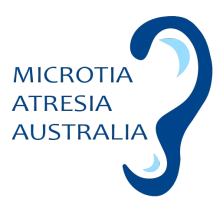GLOSSARY OF COMMON TERMS
Common terms associated with microtia and atresia
ABR (Auditory Brainstorm Response)
A test that measures the brain’s response to sound in infants and young children. The ABR test involves attaching electrodes to the head to record electrical activity from the auditory nerve (the hearing nerve) and other parts of the brain).
Anotia
Usually refers to the absence of the external ear, the auricle, the visible part of the ear.
Atresia (also called aural atresia)
The absence of an external ear canal.
Atresia Repair
Surgical procedure to make or widen the external ear canal.
Audiogram
A graph that records the results of a hearing test. It shows a person’s ability to hear different pitches (frequencies) at different volumes (intensities) of sound.
Auditory
Pertaining to the sense of hearing.
Baha
A Bone Conduction Hearing Device made by Cochlear.
Bone Anchored Hearing Aid (BAHA)
A type of hearing aid that is attached to a titanium screw implanted into the skull. It transmits sound via bone conduction. A softband version is available for small children.
Bone Conduction Hearing Aid (BCHA)
A hearing aid which transmits sound vibrations to the bones of the skull, which then conducts them directly to the inner ear, bypassing the ear canal and middle ear. Also referred to as a Bone Conduction Hearing Device.
Bonebridge
An implantable bone conduction device made by MedEl.
Bilateral
Affecting both sides.
Canalplasty (also called Atresia Repair)
Surgical procedure to make or widen the external ear canal.
Cholesteatoma
A skin growth that occurs in an abnormal location, usually in the middle ear behind the eardrum. Over time, it can increase in size and destroy the surrounding delicate hearing bones of the middle ear (ossicles).
Congenital
Relating to a condition that is present from birth.
Craniofacial
Involving the skull and the face.
CT scan (or CAT scan)
Computed Tomography imaging is a particular type of x-ray that uses multiple x-ray beams at different angles to build up a cross-section of the body’s organs and tissues. They can show several types of tissue with great clarity such as bone, soft tissue and blood.
Decibels (dB)
The unit of measurement for the loudness of sound.
ENT
Ears, Nose, Throat Specialist. Doctors who specialise in these areas are often referred to as an ENT (they can also be called an otolaryngologist).
Goldenhar Syndrome
A condition similar to Hemifacial Microsomia in that one side of the face is smaller than the other. Goldenhar will also include issues involving the eye and the spine.
Hemifacial Microsomia
A condition in which one side of the face is smaller than the other, including the jaw, ear and facial bony structures.
Medpor
A porus synthetic framework made from polyethylene that can be used in ear reconstruction surgery.
Pinna
The outer projecting portion of th eear (also called the auricle).
Prosthesis
An artificial substitute or replacement of a part of the body. Prosthetic ears are made from a soft silicone material.
Ossia
An implantable bone conduction device made by Cochlear.
Otalaryngologist
A doctor / surgeon who specialises in diagnosing and treating diseases of the head and neck, especially those involving the ears, nose and throat (commonly called an ENT).
Otologist
A doctor who specialises in the medical and surgical treatment of the ear and its diseases.
Ponto
A Bone Conduction Hearing Device made by Oticon Medical.
Rib Graft
Refers to the ear reconstruction technique that uses the patient’s own rib cartilage.
Stenosis
A narrowing of the ear canal.
Supor
A porus synthetic framework made from polyethylene that can be used in ear reconstruction surgery.
Treacher Collins Syndrome
A genetic craniofacial syndrome that is characterised by a range of distinctive facial anomalies. The main characteristics of TCS are downward slanting eyes, small lower jaw, and microtia or anotia.
Unilateral
Affecting one side.
Vibrant Soundbridge (VSB)
An implantable middle ear device made by MedEl.
ACRONYMS
Frequent acronyms associated with microtia and atresia
BMA
Bilateral Microtia Atresia (microtia and atresia on both sides)
BAHA
Bone Anchored Hearing Aid
BCHA
Bone Conduction Hearing Aid
BTE
Behind the Ear (hearing aid)
GHS
Goldenhar syndrome
HA
Hearing Australia
HFM
Hemifacial Microsomia
LMA
Left Microtia Atresia (microtia and atresia on the left side)
NDIA
National Disability Insurance Agency
NDIS
National Disability Insurance Scheme
RMA
Right Microtia Atresia (microtia and atresia on the right side)
TCS
Treacher Collins Syndrome
UHL
Unilateral Hearing Loss
UMA
Unilateral Microtia Atresia (microtia and atresia on one side)

Other Hearing Loss Information
Types of Hearing Loss
There are three types of hearing loss. Find out about them here.
Reading an Audiogram
Do you have trouble understanding an audiogram? Here is an explanation to help.
Unilateral Hearing Loss
50% of children with atresia have a unilateral hearing loss. Learn more here.
